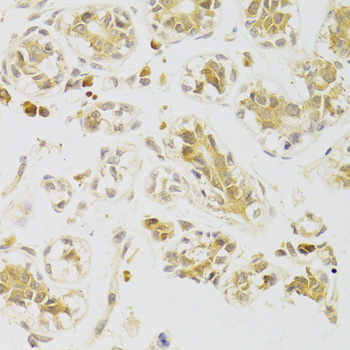Anti-Caspase-2 Antibody (CAB5724)
- SKU:
- CAB5724
- Product type:
- Antibody
- Reactivity:
- Human
- Mouse
- Rat
- Host Species:
- Rabbit
- Isotype:
- IgG
- Antibody Type:
- Polyclonal Antibody
- Research Area:
- Cell Death
Frequently bought together:
Description
| Antibody Name: | Anti-Caspase-2 Antibody |
| Antibody SKU: | CAB5724 |
| Antibody Size: | 20uL, 50uL, 100uL |
| Application: | WB IHC |
| Reactivity: | Human, Mouse, Rat |
| Host Species: | Rabbit |
| Immunogen: | Recombinant fusion protein containing a sequence corresponding to amino acids 153-452 of human Caspase-2 (NP_116764.2). |
| Application: | WB IHC |
| Recommended Dilution: | WB 1:500 - 1:2000 IHC 1:50 - 1:200 |
| Reactivity: | Human, Mouse, Rat |
| Positive Samples: | Jurkat, Rat brain |
| Immunogen: | Recombinant fusion protein containing a sequence corresponding to amino acids 153-452 of human Caspase-2 (NP_116764.2). |
| Purification Method: | Affinity purification |
| Storage Buffer: | Store at -20°C. Avoid freeze / thaw cycles. Buffer: PBS with 0.02% sodium azide, 50% glycerol, pH7.3. |
| Isotype: | IgG |
| Sequence: | KLRL STDT VEHS LDNK DGPV CLQV KPCT PEFY QTHF QLAY RLQS RPRG LALV LSNV HFTG EKEL EFRS GGDV DHST LVTL FKLL GYDV HVLC DQTA QEMQ EKLQ NFAQ LPAH RVTD SCIV ALLS HGVE GAIY GVDG KLLQ LQEV FQLF DNAN CPSL QNKP KMFF IQAC RGDE TDRG VDQQ DGKN HAGS PGCE ESDA GKEK LPKM RLPT RSDM ICGY ACLK GTAA MRNT KRGS WYIE ALAQ VFSE RACD MHVA DMLV KVNA LIKD REGY APGT EFHR CKEM SEYC STLC RHLY LFPG HPPT |
| Gene ID: | 835 |
| Uniprot: | P42575 |
| Cellular Location: | |
| Calculated MW: | 10kDa/34kDa/50kDa |
| Observed MW: | 48KDa |
| Synonyms: | CASP2, CASP-2, ICH1, NEDD-2, NEDD2, PPP1R57, caspase-2 |
| Background: | This gene encodes a member of the cysteine-aspartic acid protease (caspase) family. Caspases mediate cellular apoptosis through the proteolytic cleavage of specific protein substrates. The encoded protein may function in stress-induced cell death pathways, cell cycle maintenance, and the suppression of tumorigenesis. Increased expression of this gene may play a role in neurodegenerative disorders including Alzheimer's disease, Huntington's disease and temporal lobe epilepsy. Alternatively spliced transcript variants encoding multiple isoforms have been observed for this gene. |
| UniProt Protein Function: | CASP2: Involved in the activation cascade of caspases responsible for apoptosis execution. Might function by either activating some proteins required for cell death or inactivating proteins necessary for cell survival. Heterotetramer that consists of two anti-parallel arranged heterodimers, each one formed by a p18 subunit and a p12 subunit. Interacts with LRDD. Expressed at higher levels in the embryonic lung, liver and kidney than in the heart and brain. In adults, higher level expression is seen in the placenta, lung, kidney, and pancreas than in the heart, brain, liver and skeletal muscle. Belongs to the peptidase C14A family. 2 isoforms of the human protein are produced by alternative splicing. |
| UniProt Protein Details: | Protein type:EC 3.4.22.55; Apoptosis; Protease Chromosomal Location of Human Ortholog: 7q34-q35 Cellular Component: membrane; mitochondrion; cytoplasm; nucleus; cytosol Molecular Function:protein domain specific binding; protein binding; enzyme binding; cysteine-type endopeptidase activity Biological Process: luteolysis; nerve growth factor receptor signaling pathway; DNA damage response, signal transduction resulting in induction of apoptosis; positive regulation of apoptosis; apoptosis; positive regulation of neuron apoptosis; germ cell programmed cell death; protein processing; brain development; proteolysis; regulation of caspase activity; DNA damage response, signal transduction by p53 class mediator resulting in cell cycle arrest; aging |
| NCBI Summary: | This gene encodes a member of the cysteine-aspartic acid protease (caspase) family. Caspases mediate cellular apoptosis through the proteolytic cleavage of specific protein substrates. The encoded protein may function in stress-induced cell death pathways, cell cycle maintenance, and the suppression of tumorigenesis. Increased expression of this gene may play a role in neurodegenerative disorders including Alzheimer's disease, Huntington's disease and temporal lobe epilepsy. Alternatively spliced transcript variants encoding multiple isoforms have been observed for this gene. [provided by RefSeq, Jan 2011] |
| UniProt Code: | P42575 |
| NCBI GenInfo Identifier: | 83300977 |
| NCBI Gene ID: | 835 |
| NCBI Accession: | P42575.2 |
| UniProt Secondary Accession: | P42575,P42576, Q59F21, Q7KZL6, Q86UJ3, Q9BUP7, Q9BZK9 Q9BZL0, A8K5F9, D3DXD6, E9PDN0, |
| UniProt Related Accession: | P42575 |
| Molecular Weight: | 10,309 Da |
| NCBI Full Name: | Caspase-2 |
| NCBI Synonym Full Names: | caspase 2, apoptosis-related cysteine peptidase |
| NCBI Official Symbol: | CASP2 |
| NCBI Official Synonym Symbols: | ICH1; NEDD2; CASP-2; NEDD-2; PPP1R57 |
| NCBI Protein Information: | caspase-2; protease ICH-1; protein phosphatase 1, regulatory subunit 57; neural precursor cell expressed developmentally down-regulated protein 2 |
| UniProt Protein Name: | Caspase-2 |
| UniProt Synonym Protein Names: | Neural precursor cell expressed developmentally down-regulated protein 2; NEDD-2; Protease ICH-1Cleaved into the following 3 chains:Caspase-2 subunit p18; Caspase-2 subunit p13; Caspase-2 subunit p12 |
| Protein Family: | Caspase |
| UniProt Gene Name: | CASP2 |
| UniProt Entry Name: | CASP2_HUMAN |










